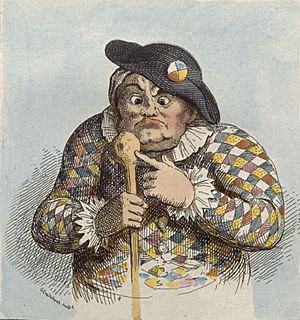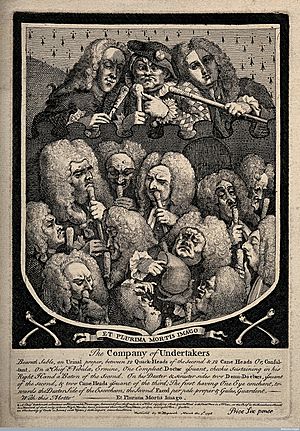Sally Mapp facts for kids
Quick facts for kids
Sally Mapp
|
|
|---|---|

1819 etching of Mapp by George Cruikshank. Mapp holds a bone in reference to her career as a bonesetter.
|
|
| Born |
Sally Wallin
|
| Baptised | 1706 |
| Died | 1737 |
| Nationality | English |
| Other names | Crazy Sally |
| Occupation | bonesetter |
| Spouse(s) |
Hill Mapp
(m. 1736–1736) |
| Parents |
|
| Family | Lavinia Fenton (sister) |
Sarah Mapp (born around 1706 – died 1737) was a famous English bonesetter. She became well-known for her amazing skills in fixing bones and joints. Bone-setting was a medical practice that used hands to move and fix injuries to bones and muscles. Sarah learned this skill from her father, who was also a bonesetter. She often helped people with injuries from horse racing. One of her most famous cases was fixing a back problem for the niece of Sir Hans Sloane. Sarah Mapp was special because she was a woman in a job mostly done by men.
Early Life and Family
Sarah Mapp was born near Wiltshire, England, and was baptized in 1706. Her parents were John and Jenny Wallin. Her father, John Wallin, was also a bonesetter. Sarah often helped her father with his patients. Sometimes, she was even better at fixing bones than he was.
Sarah later started her own practice. She called it 'Cracked Sally - the One and Only Bone Setter'. People sometimes called her 'Crazy Sally'. This nickname came from her strong personality.
Sarah's sister, Lavinia Fenton, had a very different life. Lavinia became an actress. She played Polly Peachum in a famous play called The Beggar's Opera in 1728. Later, she married Charles Powlett, 3rd Duke of Bolton.
Sarah Mapp's Practice
In the 1700s, bone-setting was usually done by men. This was because it often needed a lot of strength. People like farriers (who cared for horses) and blacksmiths (who worked with metal) often did this job. Sarah Mapp started her career when she was young. She helped her father at local races and fairs. She would announce his services to the crowd.
When her father was busy, Sarah would help his patients. She often performed amazing fixes. Her fame grew quickly. Around 1735, her reputation for fixing old dislocations and fractures brought her to Epsom. Epsom was a town with many rich families and horse racing. This meant many people needed her help. Even though Sarah did not have a lot of formal medical knowledge, she had a natural talent and the strength to put bones back in place.
The horse racing community in Epsom really liked Sarah's work. In 1736, they offered her 100 guineas (a type of money) each year to stay in Epsom. This money was for her to live there and continue her bone-setting work. While living in Epsom, she would travel to London twice a week. She saw patients at the Grecian Coffee House. Sarah traveled in style, using a fancy coach pulled by four horses. She would collect the crutches from her cured patients. She used these crutches to decorate her carriage.
At the same time, Sir Hans Sloane, a famous doctor, also saw patients at the Grecian Coffee House. Sarah Mapp became even more famous in London. This happened after she fixed a spinal problem for Sir Hans Sloane's niece.
Sarah helped many people with their injuries. Some of her notable cases are written in a book by James Caulfied. On October 21, 1736, he wrote about two amazing cures. One was for a young lady who had many bones out of place in her legs. Sarah put them all back correctly. The other was for a butcher whose knees were so misplaced that they knocked together when he walked. Sarah fixed his knees too. The next day, she performed more cures. She then left for Epsom, taking several crutches with her. She called these crutches "trophies of honour."
Some surgeons once tried to trick Sarah. They sent her a healthy patient who pretended to have a damaged wrist. Sarah was very angry when she found out. She actually dislocated the patient's wrist. Then she sent him back to the people who had tried to fool her.
Later Life and Legacy
In August 1736, Sarah Mapp got married. Her husband was a footman. In 1737, Sarah Mapp died in Seven Dials. She was buried by the local church.
Sarah Mapp was only about 30 years old when she died. But she is still remembered in history. She was known for her strong character. She was also a very successful woman in a job that was usually for men.
In Art

A song about Sarah Mapp was part of a play. The play was called The Husband's Relief. It was performed at Lincoln's Inn Fields. The song said that Sarah was better than the highly paid surgeons in London. It is said that Sarah herself went to see this play.
Her picture is at the top of a famous artwork. It is called The Company of Undertakers (Consultation of Quacks) (1736). This artwork was made by William Hogarth. He showed Sarah with other "quacks" (people who claim to have medical skills but might not be trained). Hogarth's art suggested that both these "quacks" and the official doctors of the time could lead to death. In 1819, George Cruikshank also drew a picture of Sarah Mapp. This drawing was probably based on Hogarth's work.
Originally, Sarah Mapp was very popular. People loved her because of her bone-setting skills. In Epsom, the horse racing community especially liked her. They even named a horse "Mrs. Mapp" to honor her. However, towards the end of her life, her fame started to fade. In 1736, official doctors in London began to try and stop "quacks" from working. Sarah moved to Pall Mall.
William Hogarth's print, The Company of Undertakers, also affected her popularity. He drew her in a way that made her look very masculine. Sir Percivall Pott, a famous surgeon, also criticized her. These things, along with changing ideas in society, led to her decline in popularity.
In modern books, Sarah Mapp is sometimes called an early example of osteopathy. This is a type of medicine that focuses on the body's structure. Some experts believe her treatments worked well because of the power of suggestive therapy. This means that believing in the treatment can help a person feel better.

